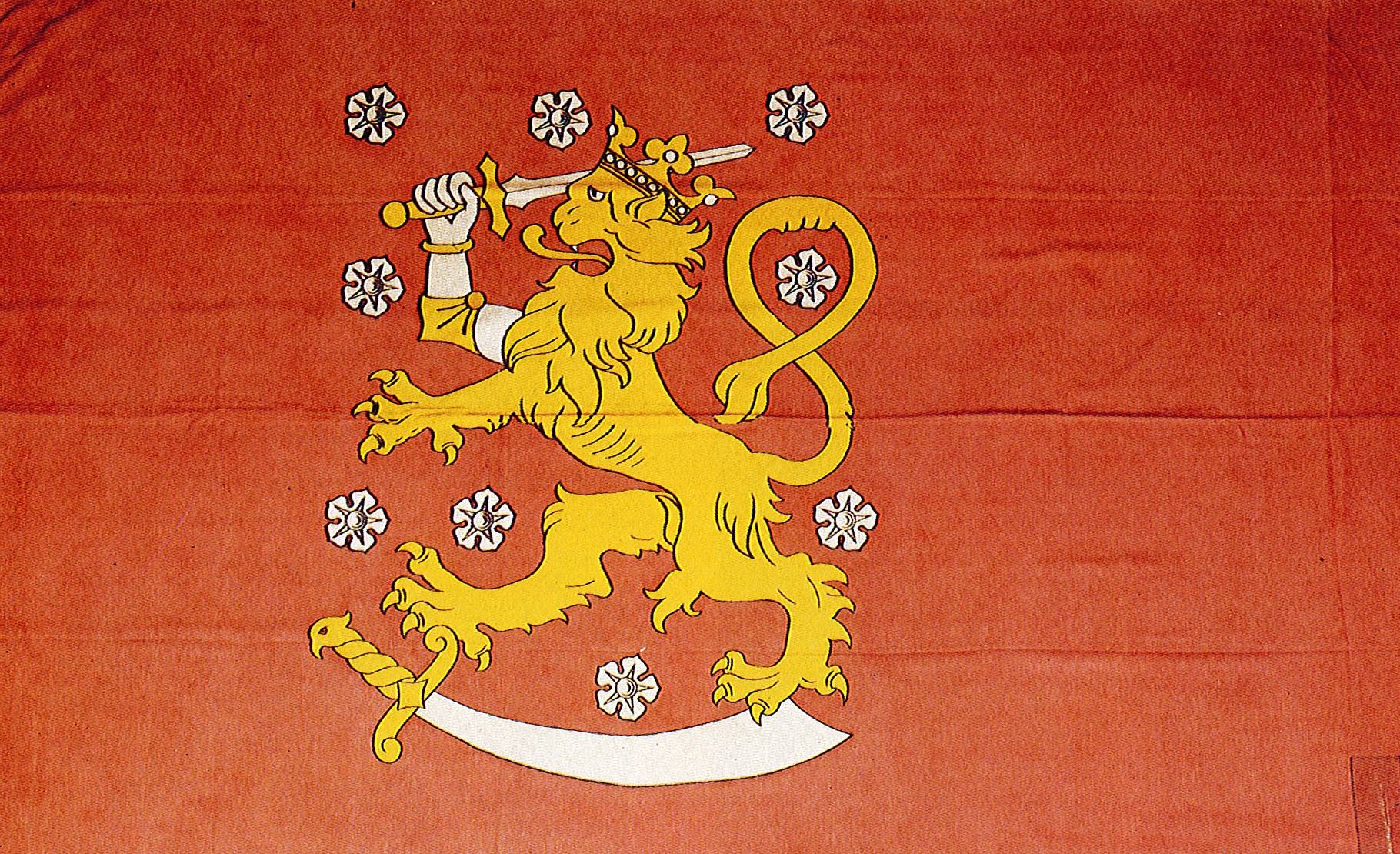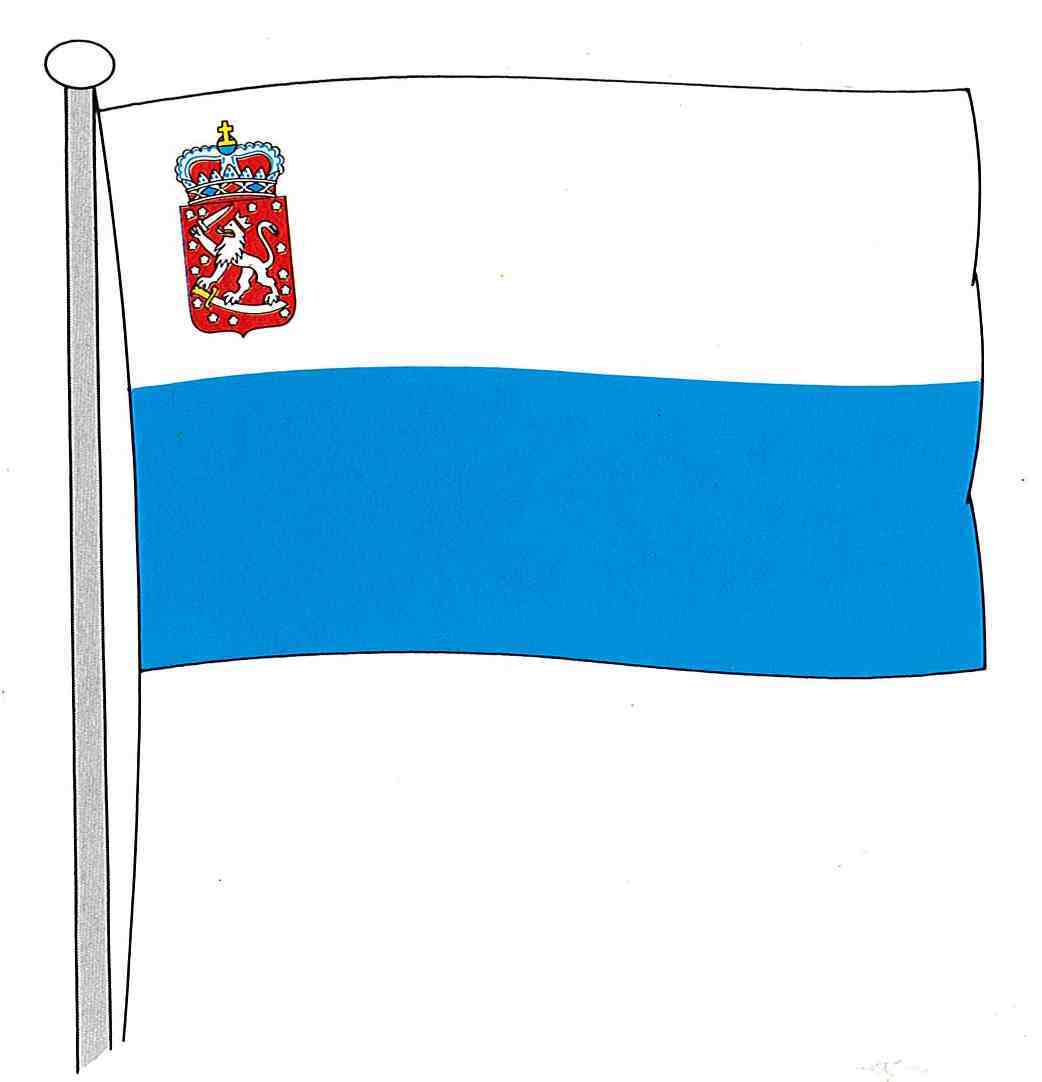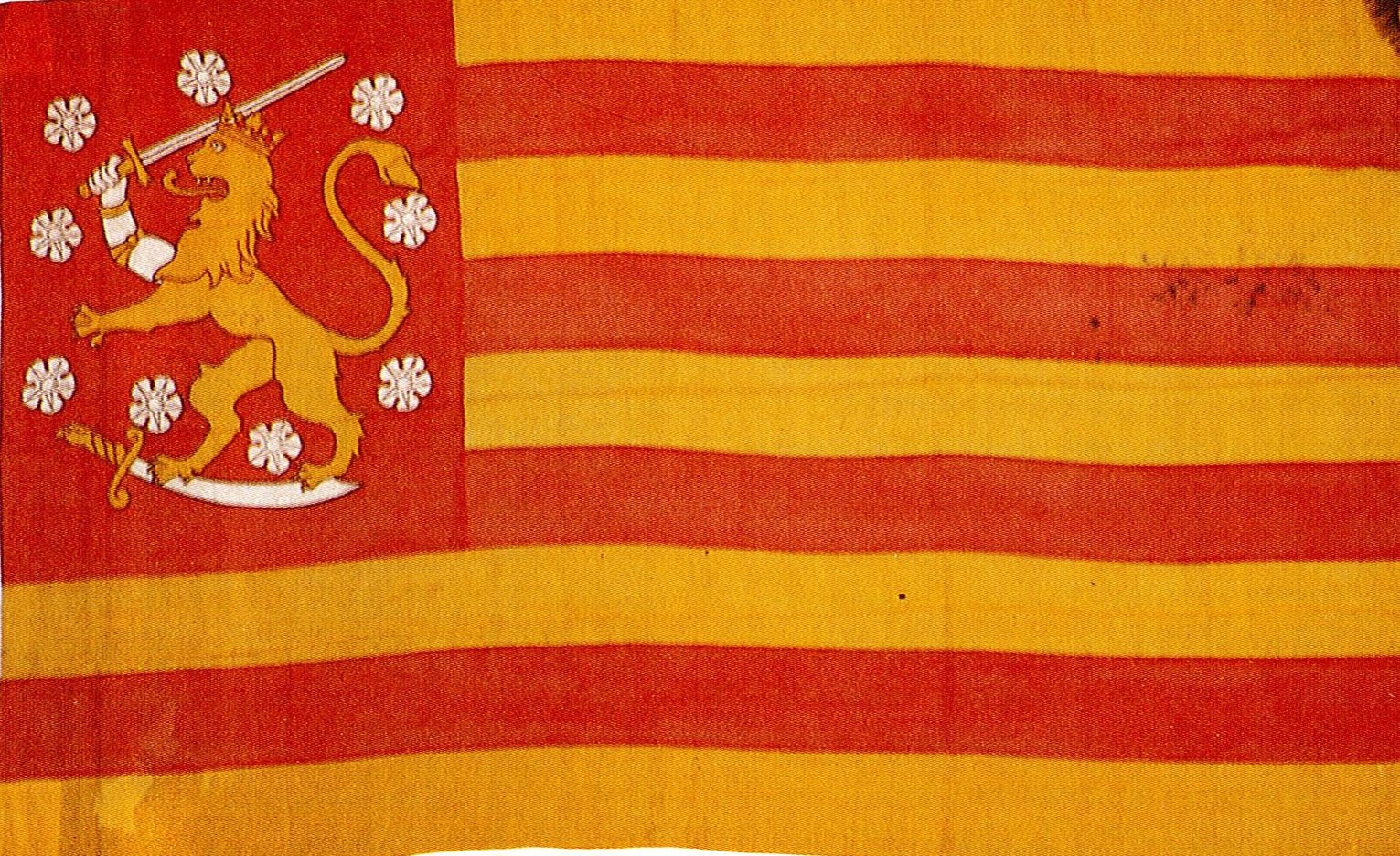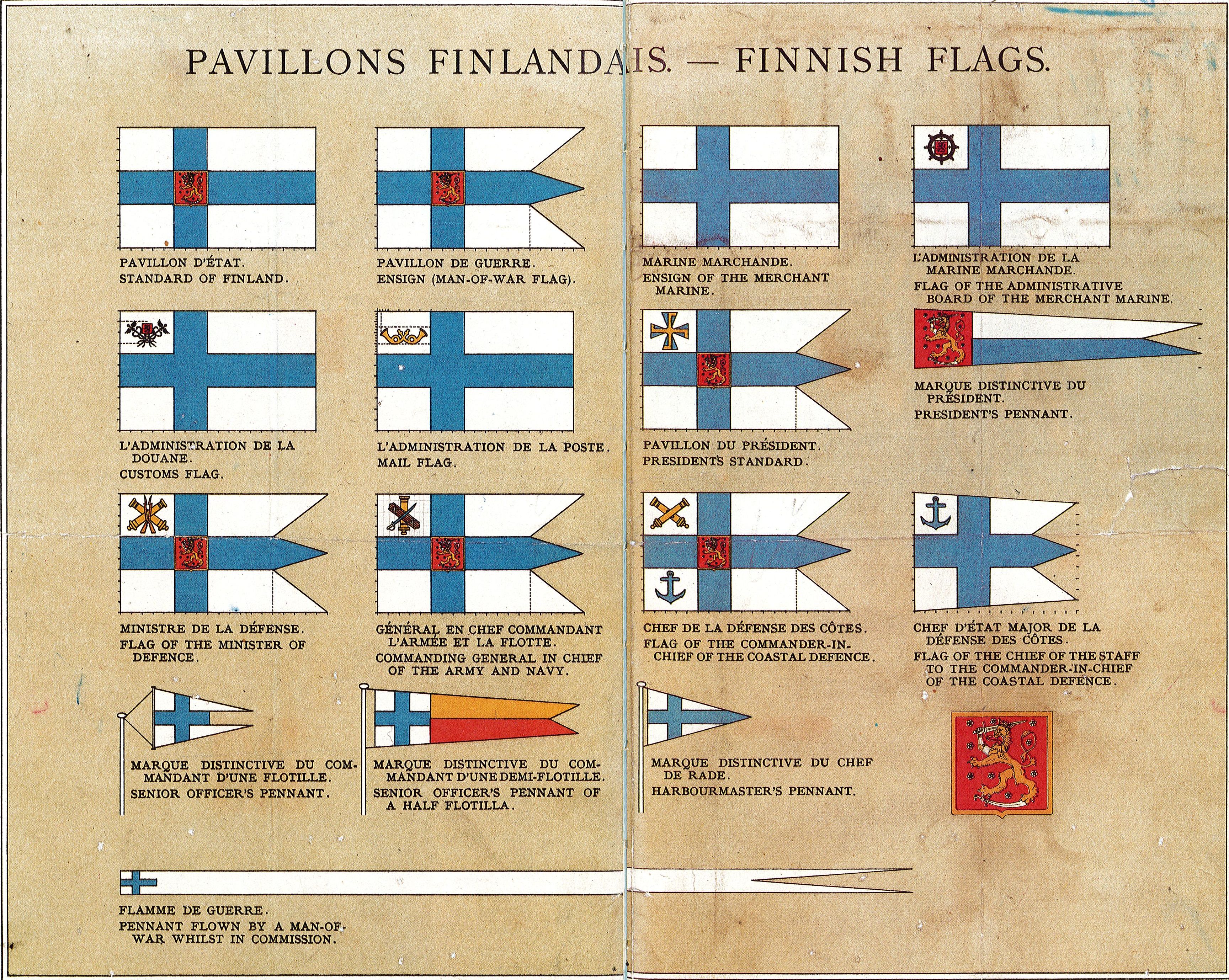Finland did not have an official flag when the country became independent. The “Blue Cross Flag” was adopted as the official flag of Finland on 28 May 1918 by decision of the Finnish parliament. It replaced the temporary state flag with the heraldic lion on red background.
The Act on the Finnish Flag, endorsed by the Senate on 29 May 1918, defined the official state flag as a “rectangular garment with a sea blue (ultramarine) cross on white background.” At the centre of the cross there is the Finnish red-and-yellow lion coat of arms. The maritime and merchant flag was the state flag without the coat of arms. The war flag was the state flag with three points. The flag was designed by Eero Snellman and Bruno Tuukkanen. The crown was removed from the coat of arms in the state flag in 1920.
The Act on the Finnish Flag was one of the first laws discussed in the parliament in May 1918 after the civil war. A majority of the parliament felt that the lion flag, which had red as its background colour, was not suitable for a Finnish state flag. The lion flag was supported by the MPs of the Swedish People’s Party and some of the representatives of the Young Finnish Party. Adding the red-and-yellow lion coat of arms to the state flag was a concession to them.
During the civil war, the Whites had flown both the lion flag and different blue-and-white flags in parades and funerals. In areas controlled by the People’s Delegation, red flags were flown. Standards of labour unions and local trade union branches were flown at funerals of Red casualties.
The birth of the blue and white flag
Various blue-and-white alternatives had been proposed already during the Russian rule. The blue and white colours became established during the 1860s in parallel with the lion flag. The Fennomans, who advocated for the strengthening of the position of the Finnish language, committed themselves politically to the blue and white colours. In its critics’ view, the blue cross reminded too much of the blue and white flags of different yacht clubs.
Immediately after Finland became independent, the state authorities, municipalities and non-socialist organisations started to fly the Blue Cross Flag during festivities. Private citizens began to fly the flag from the late 1920s on.
The Olympic Games increased people’s awareness of the Blue Cross Flag both in Finland and internationally. Hannes Kolehmainen, who won the Olympic Marathon in Antwerp, received a Blue Cross Flag on his shoulders, which was exceptional in an age that emphasised the solemnity and holiness of the flag.
The flag was made more known as it was decoratively used in various advertisements and packagings. Paavo Nurmi was depicted running against the backdrop of the Blue Cross Flag in a Karl Fazer confectionery box cover. The use of the flag in adverts was respectful. Increased visibility made the Blue Cross Flag gradually part of the Finnish imagery.
The political left’s reception of the Blue Cross Flag was initially strictly negative. The Finnish Social Democratic Party softened its position in the 1920s and accepted, for example, that the flag should be flown on Independence Day on 6 December. On the festivities of the “White Finland” the party took a negative stance and many of its members shunned the Blue Cross Flag to begin with. The communists in independent Finland were absolutely against the Blue Cross Flag.
The aversion of the working class towards the Blue Cross Flag was increased by the compulsory flying of the flag at workers’ halls in the early years of independence. In as late as 1933, supporters of the nationalist Patriotic People’s Movement (IKL) flew the Finnish flag at over a hundred workers’ halls on 16 May, on the 15th anniversary of the end of the civil war.
There were few flag days
Initially, there were only two official flag days: Independence Day on 6 December and the Army Flag Day celebrated on 16 May to commemorate the Victory Parade of the War of Independence. Midsummer Day became the Day of the Finnish Flag first unofficially in 1927 and then officially in 1934.
In addition, it was recommended to fly the flag on the birthday of J. L. Runeberg (5 February) and J. V. Snellman (12 May). On the day of Kalevala, 28 February, the flags were at the same time flown in Elias Lönnrot’s honour. Finnish-speaking students in particular worked hard to make Aleksis Kivi’s birthday (10 October) a national flag day, which finally happened in the 1930s. Flying the flag on Mother’s Day – which has been celebrated in Finland since 1918 – also became an established custom.
Flag days sparked controversial feelings in different social circles. J. L. Runeberg was too “Swedish” for many Finnish-speaking people. On the other hand, Aleksis Kivi and Elias Lönnrot were strangers to a large part of the Swedish-speaking population. In principle, J. V. Snellman was the person who best united Finns. However, much to the annoyance of other groups, the Fennomans appropriated the Snellman celebrations.
The less than enthusiastic attitude of the Swedish-speaking people to the Blue Cross Flag was apparent in the coastal regions of Ostrobothnia where people flew red and yellow colours alongside the official flag.
War years united the nation under one flag
The war years changed Finns’ attitudes towards the Blue Cross Flag. At funerals of fallen soldiers, the coffin was covered with the national flag, linking together the fatherland and the sacrifice made for it. The fallen were from all classes of society and they had had different political views. Social Democrat MP Sylvi-Kyllikki Kilpi summarised the change in the nature of the Blue Cross Flag at a Labour Flag Celebration in Vallila, Helsinki, on Midsummer’s Eve 1940:
“After the events of last winter, the national flag has reached its right place in our minds. It is a symbol of our free and independent country and numerous are the socialist and class-conscious workers who gave their lives on behalf of their homeland and whose bodies, covered in the flag, now rest in the churchyards of their home towns.”
The Blue Cross Flag was repeated in many ways in the war-time imagery. Great numbers of small national flags, sold by Finnish Lottas, were waved eagerly at the Finnish-Swedish-German athletics competition in September 1940. In the early stages of the Continuation War, people repeatedly got to see images of Blue Cross Flags being returned to the areas lost in the Winter War. The hoisting of the Finnish war flag on top of the tower of Vyborg castle at the end of August 1941 was a deeply symbolic event.
After the war, even the communists marched behind the Blue Cross Flag in their May Day marches. The idea of the nation and what it encompassed was being redefined. By accepting the Blue Cross Flag the communists were declaring that they represented the people and worked for the good of the people.






